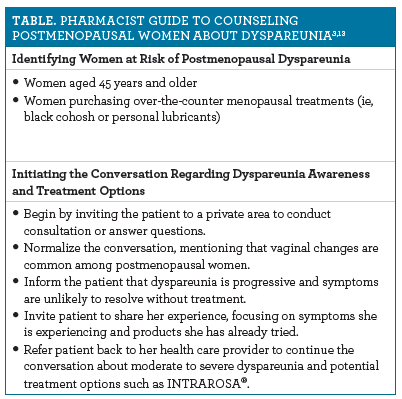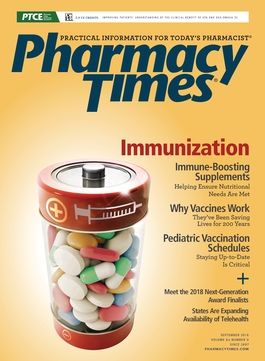Publication
Article
Pharmacy Times
Importance of Pharmacist Counseling to Increase Awareness of Available Treatments for Moderate to Severe Dyspareunia Among Postmenopausal Women
Vulvovaginal atrophy, a component of the genitourinary syndrome of menopause, is characterized by a range of symptoms associated with the declining levels of estrogen among postmenopausal women.
This article was sponsored by AMAG Pharmaceuticals.
Vulvovaginal atrophy (VVA), a component of the genitourinary syndrome of menopause, is characterized by a range of symptoms associated with the declining levels of estrogen among postmenopausal women. These include vaginal dryness, burning, and itching; dysuria, or painful urination; recurrent urinary tract infections; and dyspareunia, or painful sexual intercourse.1-3 As a result of declining estrogen levels, physiologic changes in the vulvovaginal area may lead to increased pH and loss of lubrication, elasticity, and pliability in vaginal tissue, causing
dyspareunia.2-4 VVA symptoms, including dyspareunia, are progressive and may not resolve without effective treatment.3
Dyspareunia Prevalence, Awareness, and Unmet Treatment Needs Among Postmenopausal Women
The REVIVE and EMPOWER surveys evaluated the prevalence and impact of VVA symptoms, perceptions and awareness of VVA and its associated symptoms, knowledge of treatment options, frequency of unmet needs, and barriers to awareness and effective treatment.2,3 Of the 10,390 postmenopausal women surveyed across REVIVE (N = 8081) and EMPOWER (N = 2309), at least 1 VVA symptom was experienced by 38% and 80% of women in each survey, respectively. Among those with at least 1 VVA symptom, 44% and 59% reported experiencing dyspareunia in the REVIVE and EMPOWER surveys, respectively.2,3 Additionally, more than half of postmenopausal women with dyspareunia in the EMPOWER survey rated their discomfort as moderate to severe (54%).2 Despite the prevalence of moderate to severe dyspareunia as a VVA symptom in postmenopausal women, these surveys also revealed that a substantial number of women were unaware of both VVA as a condition and its available treatment options, and therefore remained untreated.2 In the EMPOWER survey, fewer than 40% of women surveyed were aware of VVA as a condition, and half of women with VVA symptoms had never received treatment.2
Surprisingly, only about half of women in the REVIVE (44%) and EMPOWER (56%) surveys had conversed with their health care provider (HCP) regarding their VVA symptoms.2,5 Barriers to this discussion were highlighted in the EMPOWER study, in which 18% of women reported that they were uncomfortable discussing their symptoms, 13% shared that they were unaware of treatment options for their symptoms, and 42% believed that VVA was a natural part of aging, with which they should live.2 Importantly, failure of HCPs to initiate conversations regarding VVA during routine visits was also highlighted. For women who had talked to their HCPs about VVA, fewer than 15% of conversations were initiated by the HCP.2,5 Discouragingly, HCPs mentioned to 20% of women that VVA symptoms were a normal part of aging with which they should learn to live.2 Overall, the REVIVE and EMPOWER surveys have revealed the need for a better understanding of both VVA and available treatment options among patients and HCPs.
INTRAROSA® (prasterone)
INTRAROSA® is a steroid indicated for the treatment of moderate to severe dyspareunia, a symptom of VVA, due to menopause.6 INTRAROSA® is a once-daily 6.5-mg intravaginal insert of prasterone that should be administered using the provided applicator every night at bedtime in either the lying or standing position.6 Although the mechanism of action of INTRAROSA® is not completely understood, prasterone is a synthetic version of an inactive endogenous steroid that is converted into androgens and estrogens.6
Clinical Efficacy of INTRAROSA® in Providing Relief for Moderate to Severe Dyspareunia
The efficacy of INTRAROSA® was established across four phase 3 clinical trials in postmenopausal women who reported moderate to severe dyspareunia as their most bothersome symptom of VVA. Patients treated with INTRAROSA® achieved improvements in all FDA-designated co-primary efficacy end points, which included the physiologic markers of VVA (increased percentage of vaginal superficial cells, decreased percentage of parabasal cells, and decreased vaginal pH) and reductions in the severity score for dyspareunia.6-9 In a combined analysis across three 12-week clinical trials, INTRAROSA® treatment decreased the severity score of dyspareunia by an average of 48.9% compared with placebo (P <.0001).8,10-12 In a long-term open-label trial, INTRAROSA® reduced the severity of dyspareunia with a 46.7% decrease in severity score at 12 weeks and a 66.1% total decrease in severity score over the 52 weeks from start of the study (P <.0001).7
Safety Considerations With INTRAROSA®
Before starting INTRAROSA® treatment, pharmacists should counsel postmenopausal women regarding safety considerations, such as vaginal discharge and abnormal Pap smears.6 Vaginal discharge at the application site, which was attributed to melting suppository leakage, was the most frequently reported treatment-emergent adverse effect (AE) across the 12-week trials, occurring at an average incidence of 5.7% in the INTRAROSA® treatment group.6-8,11,12 In the 52-week open-label clinical trial, AEs which occurred at an incidence of 2% or greater were vaginal discharge (14.2%) and abnormal findings on a Pap smear (2.1%).6 Patients should be advised to speak with their prescriber if they have a current or past history of breast cancer, and if they have undiagnosed abnormal genital bleeding.6
Role of the Pharmacist
Pharmacists are uniquely positioned to address the unmet need for dyspareunia awareness and to counsel postmenopausal women on available treatment options for dyspareunia, including specific information regarding INTRAROSA® for those with moderate to severe dysparenuia. Given that there often is a failure to initiate conversations around VVA in the postmenopausal population, pharmacists with an understanding of potential barriers to discussing this sensitive condition may be better equipped to initiate conversations with patients when appropriate. Encouragingly, 87% of postmenopausal women in the EMPOWER survey reported they would be likely to talk about their vaginal symptoms if their HCP initiates the conversation.2
Patients who are purchasing over-the-counter products or prescriptions at the pharmacy for the relief of dyspareunia may provide pharmacists with an opportunity to open a discussion about awareness of the condition and available treatment options. After initiating a conversation, the pharmacist can then refer the patient to her HCP for further evaluation, armed with knowledge to ask questions about treatments for moderate to severe dysparenuia such as INTRAROSA®. The TABLE summarizes how to best identify and counsel women who may be at risk of postmenopausal dyspareunia and provides suggestions for opening a dialogue.3,13 Pharmacists have an important role in fostering a positive counseling environment for postmenopausal women and encouraging open discussions regarding dyspareunia and VVA symptoms.

Indication
INTRAROSA® is a steroid indicated for the treatment of moderate to severe dyspareunia, a symptom of vulvar and vaginal atrophy, due to menopause.
Important Safety Information
INTRAROSA® is contraindicated in women with undiagnosed abnormal genital bleeding.
Estrogen is a metabolite of prasterone. Use of exogenous estrogen is contraindicated in women with a known or suspected history of breast cancer. INTRAROSA® has not been studied in women with a history of breast cancer.
In four 12-week randomized, placebo-controlled clinical trials, the most common adverse reaction with an incidence ≥2 percent was vaginal discharge. In one 52-week open-label clinical trial, the most common adverse reactions with an incidence ≥2 percent were vaginal discharge and abnormal Pap smear.
To report SUSPECTED ADVERSE REACTIONS, contact AMAG Pharmaceuticals at 1-877-411-2510 or FDA at 1-800-FDA-1088 or www.fda.gov/medwatch.
Please consult full Prescribing Information for complete product information.
References
1. Shifren JL. Genitourinary syndrome of menopause. Clin Obstet Gynecol. 2018;61(3):508-516. doi: 10.1097/GRF.0000000000000380.
2. Kingsberg SA, Krychman M, Graham S, Bernick B, Mirkin S. The women’s EMPOWER survey: identifying women’s perceptions on vulvar and vaginal atrophy and its treatment. J Sex Med. 2017;14(3):413-424. doi: 10.1016/j.jsxm.2017.01.010.
3. Wysocki S, Kingsberg S, Krychman M. Management of vaginal atrophy: implications from the REVIVE Survey. Clin Med Insights Reprod Health. 2014;8:23-30. doi: 10.4137/CMRH.S14498.
4. Portman DJ, Gass ML; Vulvovaginal Atrophy Terminology Consensus Conference Panel. Genitourinary syndrome of menopause: new terminology for vulvovaginal atrophy from the International Society for the Study of Women’s Sexual Health and the North American Menopause Society. Menopause. 2014;21(10):1063-1068. doi: 10.1097/GME.0000000000000329.
5. Kingsberg SA, Wysocki S, Magnus L, Krychman ML. Vulvar and vaginal atrophy in postmenopausal women: findings from the REVIVE (REal Women’s VIews of Treatment Options for Menopausal Vaginal ChangeEs) survey. J Sex Med. 2013;10(7):1790-1799. doi: 10.1111/jsm.12190.
6. Intrarosa [package insert]. Waltham, MA: AMAG Pharmaceuticals; 2018.
7. Labrie F, Archer DF, Bouchard C, et al; Members of the VVA Prasterone Group. Prasterone has parallel beneficial effects on the main symptoms of vulvovaginal atrophy: 52-week open-label study. Maturitas. 2015;81(1):46-56. doi: 10.1016/j.maturitas.2015.02.005.
8. Labrie F, Archer DF, Martel C, Vaillancourt M, Montesino M. Combined data of intravaginal prasterone against vulvovaginal atrophy of menopause. Menopause. 2017;24(11):1246-1256. doi: 10.1097/GME.0000000000000910.
9. Center for Drug Evaluation and Research (CDER) of the Food and Drug Administration, US Department of Health and Human Services. Guidance for industry: estrogen and estrogen/progestin drug products to treat vasomotor symptoms and vulvar and vaginal atrophy symptoms— Recommendations for clinical evaluation. fda.gov/downloads/Drugs/GuidanceComplianceRegulatoryInformation/Guidances/UCM071643.pdf. Published January 2003. Accessed July 23, 2018.
10. Labrie F, Archer DF, Bouchard C, et al. Intravaginal dehydroepiandrosterone (prasterone), a highly efficient treatment of dyspareunia. Climacteric. 2011;14(2):282-288. doi: 10.3109/13697137.2010.535226.
11. Archer DF, Labrie F, Bouchard C, et al; VVA Prasterone Group. Treatment of pain at sexual activity (dyspareunia) with intravaginal dehydroepiandrosterone (prasterone). Menopause. 2015;22(9):950-963. doi: 10.1097/GME.0000000000000428.
12. Labrie F, Archer DF, Koltun W, et al; VVA Prasterone Research Group. Efficacy of intravaginal dehydroepiandrosterone (DHEA) on moderate to severe dyspareunia and vaginal dryness, symptoms of vulvovaginal atrophy, and of the genitourinary syndrome of menopause. Menopause. 2016;23(3):243-256. doi: 10.1097/GME.0000000000000571.
13. Intrarosa [discussion guide]. Waltham, MA: AMAG Pharmaceuticals; 2018.
INTRAROSA is a registered trademark of Endoceutics, Inc. Distributed by AMAG Pharmaceuticals, Inc. Waltham, MA 02451.
PP-INR-US-00438








